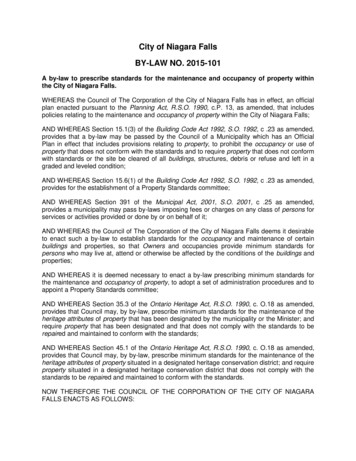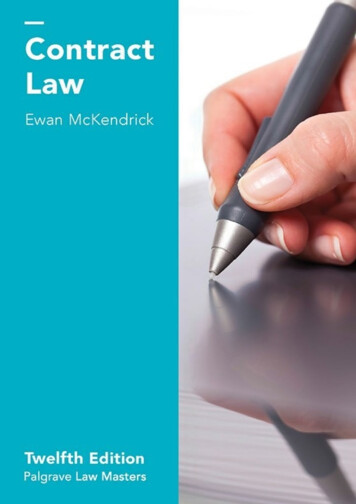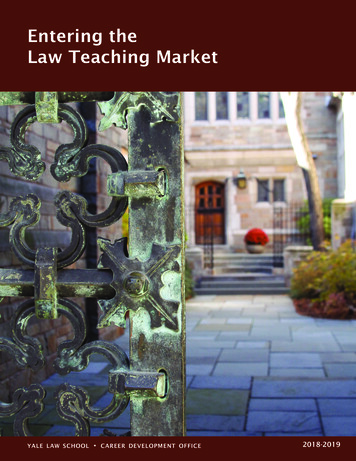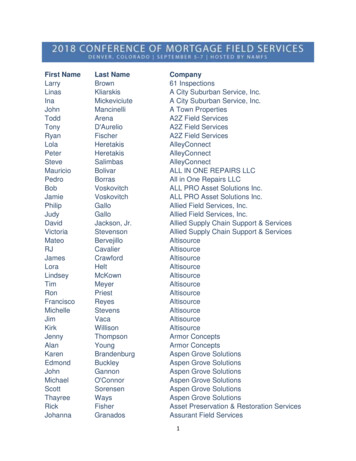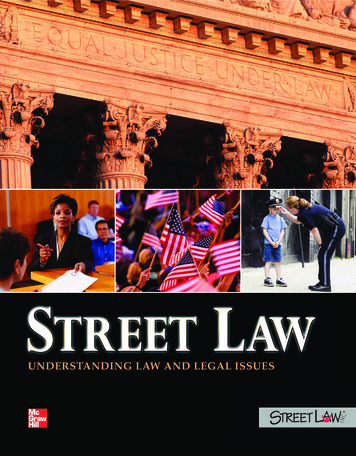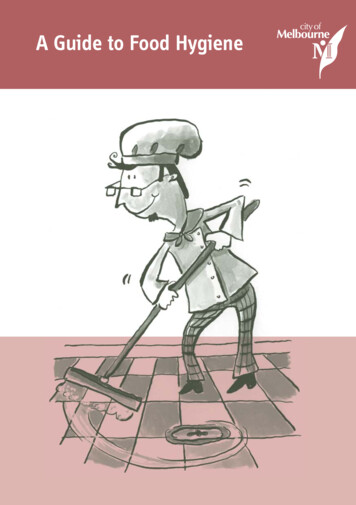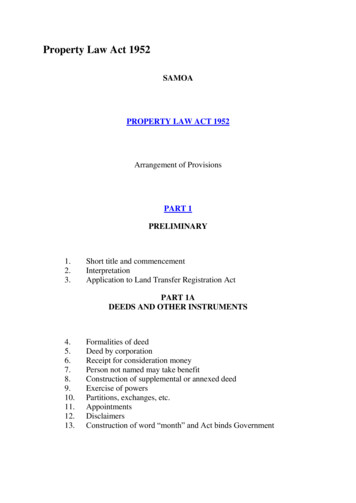
Transcription
Property Law Act 1952SAMOAPROPERTY LAW ACT 1952Arrangement of ProvisionsPART 1PRELIMINARY1.2.3.Short title and commencementInterpretationApplication to Land Transfer Registration ActPART 1ADEEDS AND OTHER INSTRUMENTS4.5.6.7.8.9.10.11.12.13.Formalities of deedDeed by corporationReceipt for consideration moneyPerson not named may take benefitConstruction of supplemental or annexed deedExercise of powersPartitions, exchanges, etc.AppointmentsDisclaimersConstruction of word “month” and Act binds Government
PART 2GENERAL RULESAFFECTING PROPERTY14. Uses not necessary15. Certain forms of assurance abolished16. Estates tail abolished17. Estates by wrong abolished18. Freehold in future may be created19. Estate in chattel real may be created by deed20. When contingent remainders capable of taking effect21. Rights of entry, etc.22. Certain expressions to be words of purchase, rule in Shelley’s caseabolished23. Restriction on executory limitations24. Rule against perpetuities not to apply to superannuation funds25. Validation of certain gifts void for remoteness26. Possibility upon a possibility27. Repealed28. Vendor’s lien taken away29. Equitable waste30. No merger by operation of law31. Release of part of land charged not to be extinguishment of rent32. Corporations may hold as joint tenants33. Alienation of property may be restricted34. Disclaimer of powers35. Intermediate income of contingent or executory gifts36. Receipts for income by married infants37. “Heirs” and other words interpreted38. “Heirs of the body” and other words interpreted39. Repealed40. Appointments valid despite objects excluded41. Restrictions on accumulation42. Qualification of restrictions on accumulationPART 3ASSURANCES OF REALAND PERSONAL PROPERTY43.44.Fee to pass without words of limitationForm of conveyance
45.46.47.48.49.Conveyance to vest ownershipConveyance subject to trustWhat a conveyance of land is deemed to includeDeclaration by tenants in common to become joint tenantsPerson may convey property to himself or herself.PART 4POWERS AND CONDITIONSOF SALE AND PROTECTIONOF PURCHASERS AND CREDITORS50.51.52.Restrictions on and relief against rescissionAuction salesApplication of stated conditions of sale52A. Conditions of sale of land under the provisions of the Land TitlesRegistration Act racts where certificate of title is limitedRights of purchaser as to executionPayment of consideration money to solicitorValidity of conveyances by executors, etc.Restriction on constructive noticeOrders of Court conclusiveAlienation with intent to defraud creditorsVoluntary alienation of land with intent to defraud purchaserPurchase in good faith of reversion not to be set aside for undervaluePART 5COVENANTS AND POWERS63. Benefit of covenants relating to land64. Burden of covenants relating to land65. Effect of covenants relating to land66. Covenants and agreements made by a person with himself or herselfand others67. Covenants to be joint and several68. Implied covenants may be negatived69. Benefit of covenant for title
70.71.Construction of covenantsPower to re-enter not impliedPART 6COVENANTS IMPLIED INCONVEYANCE GENERALLY72.73.74.75.Covenants implied in conveyance by way of sale, etc.Covenants implied in conveyance subject to encumbranceCovenants implied in conveyance of term of yearsCovenants implied in conveyance by trustees, etc.PART 7MORTGAGESDivision 1 – General Provisions76.77.78.79.80.Form of mortgageNo equitable mortgage by deposit of deedsCovenants, etc., implied in all mortgagesEndorsements on mortgagesEffect of advance on joint account, etc.80A.Security for further advancesDivision 2 – Redemption81.82.83.84.85.86.87.Equity of redemptionMortgagor may require mortgagee to assign instead of reconveyingEncumbrancer to have the like rightPower for mortgagor to inspect title deedsRestriction on consolidationSale of mortgaged property in action for redemptionRepayment when mortgagee cannot be found, etc.
Division 3 – Rights of Mortgagor in Possession88.Suit for possession of land by mortgagorDivision 4 – Powers and Rights of mortgagee and Restrictions Thereon89. Foreclosure prohibited90. Mortgagee accepting interest not to call up without notice91. Powers of mortgagee in possession92. Restriction on exercise by mortgagee of his or her rights93. Power to authorise land and minerals to be dealt with separately bymortgagee94. Power of sale in mortgage includes certain powers incident thereto95. Mortgagee in possession may cut and sell certain trees96. Application of last two sections97. Mortgaged property may be sold or leased together at one price orrent98. Mortgagee’s receipts, discharges, etc.98A. Transfer by mortgageeDivision 5 – Sale by Mortgagee Through Registrar of Supreme Court99.100.101.102.103.Sale of mortgaged land by RegistrarMortgagor may redeem at mortgagee’s valuationMortgagor may become purchaserProtection of bona fide purchaserFees payable on applicationsDivision 6 – Liability to Mortgagee of Purchaser of Land Subject toMortgagee104. Purchaser personally liable to mortgagee
PART 8LEASES AND TENANCIES:Division 1 – General 115.116.Tenancy from year to year not to be impliedCovenants implied in leasesPowers in lessorEffect of licence to assignNo fine for licence to assignLicence or consent not to be unreasonably withheldMerger of reversion not to affect remediesRent and benefit of lessee’s covenants to run with reversionObligation of lessor’s covenants to run with reversionApportionment of conditions on severance, etc.Restriction on effect of waiverExecutor not personally liable for covenantsDivision 2 – Relief Against Forfeiture117. Interpretation118. Restrictions on and relief against forfeiture119. Protection of under lessees on forfeiture of superior leasesDivision 3 – Relief Against Refusalto Grant Renewal, etc.120. Relief of lessee against refusal of lessor to grant a renewal or toassure the reversion121. Limitation of time for application for reliefPART 9EASEMENTS, RESTRICTIVE STIPULATIONS ANDENCROACHMENTS:
Division 1 – Easements in Gross122. Easement in gross permittedDivision 2 – Light and Air123. Access or use of light or air124. Conditions precedent to grant of right of light or air125. Effect of grants126. Registration of restrictions of user of land127. Power for Court to modify or extinguish easements and restrictivestipulationsDivision 3 – Encroachments128. District Court may authorise entry for erecting or repairing buildings,etc.129. Power of Court to grant special relief in cases of encroachmentPART 10ASSIGNMENTS OF THINGSIN ACTION130. Assignment of debts and things in actionPART 11MARRIAGE SETTLEMENTS131. Implied powers in tenants for life132. Powers of trustees of settlementDivision 1 - Marriage Settlements by Minors133. Sanction of Court to be obtained
PART 12POWERS OF ATTORNEY134.135.136.137.138.139.Execution by attorney in his or her own nameContinuance until notice of death or revocation receivedIrrevocable power of attorney for valuePower of attorney made irrevocable for fixed timeConveyance under power of attorney from person not in SamoaApplications to corporationsPART 13PARTITION OF LAND AND DIVISION OF CHATTELS140.141.142.143.In action for partition Court may direct land to be soldProceeds of sale, how appliedCosts in partition suitsDivision of chattelsPART ncome apportionable in respect of timeTime when apportioned part payableRecovery of apportioned partsExceptions and applicationPART 15DEBTS CHARGED ON REAL ESTATE149. Devisee, etc., of real estate not to claim payment of mortgage out ofpersonal estatePART 16RENT CHARGES AND OTHERANNUAL SUMS
150. Recovery of annual sums charged on landDivision 1 – Discharge of Encumbrances on Sale151. Provision by Court for encumbrances on salePART 17SERVICE OF NOTICES152. Service of noticesPART 18MISCELLANEOUS153. Restriction on validation of instruments154. Protection of solicitors and trustees acting under this Act155. Repeals and savingsSchedulesPROPERTY LAW ACT 19521952 No. 52AN ACT to consolidate and amend certain enactments relating to property.[Assent date: 24 October 1952][Commencement date: 1 January 1953]
PART 1PRELIMINARY1. Short title and commencement – This Act may be cited as the Property LawAct 1952, and comes into force on 1 January 1953.2. Interpretation – In this Act, unless the context otherwise requires:“bankruptcy” includes an act or proceeding in law having, under an Act in force,effects or results similar to those of bankruptcy; and “bankrupt” has acorresponding meaning“conveyance” in relation to land under the Land Titles Registration Act 2008,includes the term “transfer”;“Court” means the Supreme Court;“encumbrance” includes a mortgage in fee or for a less estate, and a trust forsecuring money, and a lien, and a charge of a portion, annuity, or other capital orannual sum; and “encumbrancer” has a corresponding meaning, and includes aperson entitled to the benefit of an encumbrance, or entitled to require payment ordischarge thereof;“executors” and “administrators” of a deceased person mean respectively thepersons to whom the right to administer the estate of the deceased has been grantedby the proper Court, whether for general, special, or limited purposes; and“executors” includes executors by right of representation;“income”, when used with reference to land, includes rents and profits;“instrument” includes conveyance deed, will, appointment, lease, settlement orother assurance of property, proclamation taking land, and Act of Parliament;“land” includes all estates and interests, whether freehold or chattel, in realproperty;“mortgage” includes a charge on a property for securing money or money’s worth;and “mortgage money” means money or money’s worth secured by a mortgage;
“mortgagee” includes a person receiving title under the original mortgagee; and“mortgage” in possession” means a mortgagee who in right of the mortgage hasentered into and is in possession of the mortgaged property;“mortgagor” includes a person deriving title under the original mortgagor, orentitled to redeem a mortgage, according to his or her estate, interest, or right in themortgaged property;“possession”, when used with reference to land, includes the receipt of incometherefrom;“property” includes real and personal property, and an estate or interest in aproperty real or personal, and a debt, and a thing in action, and any other right orinterest;“purchaser” includes a lessee or mortgagee, or other person who for valuableconsideration takes or deals for any property; and “purchase” has a correspondingmeaning; but “sale” means only a sale properly so called;“registered” or “duly registered” means registered in the manner provided by theLand Registration Act where the land affected is under that Act, and “registration”has a corresponding meaning;“Registrar” means the Registrar of the Supreme Court, and includes a DeputyRegistrar or in any case where the Deputy may lawfully act for and on behalf ofthe Registrar;“rent” includes yearly or other rent, toll, duty, royalty, or other reservation by theacre, the ton, or otherwise; and “fine” includes premium or foregift, and a payment,consideration, or benefit in the nature of a fine, premium, or foregift;“will” includes codicil.3. Application to Land Titles Registration Act – (1) This Act is to be read andconstrued so as not to conflict with the provisions of the Land Titles RegistrationAct 2008 as regards land under that Act.(2) Except as otherwise expressly provided, all the provisions of this Act shall, asfar as they are applicable, apply to land and instruments under the LandTitles Registration Act 2008 as well as to other land and instruments.(3) The provisions of this Act which are specified in the First Schedule do notapply to land or instruments under the Land Titles Registration Act 2008.
PART 1ADEEDS AND OTHER INSTRUMENTS4. Formalities of deed – (1) A deed, whether or not affecting property, shall besigned by the party to be bound thereby it, and shall also be attested by at least 1witness, and, if the deed is executed in Samoa, the witness shall add to his or hersignature his or her place of abode and calling or description, but no particularform of words are requisite for the attestation.(2) Except where the party to be bound by a deed is a corporation, sealing is notnecessary.(3) Formal delivery and indenting are not necessary in any case.(4) A deed executed as required by this section is binding on the party purported tobe bound thereby.(5) A deed, including a deed of appointment, executed before the commencementof this Act which is attested in the manner required or authorised by an enactmentproviding for the execution and attestation of deeds in force at the time ofexecution, or at any time subsequent thereto, is deemed to be and to have been asvalid and effectual as if it had been attested as required by this section.5. Deed by corporation – A deed that may be lawfully made by a corporation(whether executed before or after the commencement of this Act):(a) to which the common or official seal of the corporation is affixed; or(b) which is executed in the name of the corporation by a person who has beenappointed its attorney, and has at the time of execution made a statutorydeclaration that he or she is the attorney of the corporation acting under a power ofattorney specified by the appointed attorney, and that he or she has executed thedeed under the powers thereby conferred, and that he or she has not at the time ofmaking the declaration received a notice of the revocation of the power of attorneyby the dissolution of the corporation or otherwise,is taken to have been duly executed by the corporation, and binds the corporation;and all persons dealing in good faith without notice of an irregularity are entitled topresume the regular and proper execution of the deed, and to act accordingly.
6. Receipt for consideration money – An acknowledgement of the receipt of theconsideration contained in the body of a deed is valid and effectual in all respectsas if the same had also been endorsed thereon.7. Person not named may take benefit – A person may take an immediate benefitunder a deed, although not named as a party thereto.8. Construction of supplemental or annexed deed – A deed expressed to besupplemental to a previous deed, or directed to be read as an annex thereto, shall,as far as may be, be read and have effect as if the deed so expressed or directedwere made by way of endorsement on the previous deed, or contained a full recitalthereof.9. Exercise of powers – Where a power of appointment by deed or writing,otherwise than by will, is exercised by deed executed in the manner required bythis Act, the deed is deemed to be a valid exercise of the power, despite that by theinstrument creating the power some additional or other form of execution isrequired.10. Partitions, exchanges, etc. – No partition, exchange, lease, assignment, orsurrender (otherwise than by operation of law) of any land is valid at law unless thesame is made by deed, except a lease for a term not exceeding a tenancy of 1 year,which lease may be made either by writing or by parol.11. Appointments – No appointment to be made by deed or writing (otherwisethan by will) in exercise of a power is valid unless the same is executed as a deedis required to be executed.
12. Disclaimers – No disclaimer of any land is valid unless the same is made bydeed or by matter of record.13. Construction of word “month” and Act binds Government – (1) In alldeeds, contracts, wills, orders, and other instruments executed or made on or after5 December 1944 (being the date of the passing of the Law Reform Act 1944),unless the context otherwise requires, “month” means a calendar month.(2) This Act binds the Government.PART 2GENERAL RULES AFFECTING PROPERTY14. Uses not necessary – A limitation which at any time heretofore might havebeen made by way of shifting, springing, or executory use may be made by directconveyance without the intervention of uses.15. Certain forms of assurance abolished – The legal estate in any land shall notpass by a covenant to stand seised, or by any contract for the sale and purchase ofland, or by livery of seism.16. Estates tail abolished – (1) In an instrument coming into operation after thecommencement of this Act, a limitation which, if this section had not been passed,would have created an estate tail (legal or equitable) in any land in favour of aperson is deemed to create an estate in fee simple (legal or equitable, as the casemay be) in that land in favour of that person to the exclusion of all estates orinterest limited to take effect after the determination or in defeasance of any suchestate tail.(2) If, at the commencement of this Act, a person is entitled to an estate tail (legalor equitable), whether in possession, reversion, or remainder, in any land, thatperson, except as mentioned in subsection (3), is taken to be entitled to an estate infee simple (legal or equitable, as the case may be) in that land, to the exclusion of
all estates or interests limited to take effect after the determination or in defeasanceof any such estate tail.(3) In subsection (2),“estate tail” includes that estate in fee into which an estate tailis converted where the issue in tail is barred, but the person claiming estates byway of remainder are not barred; also an estate in fee voidable or determinable bythe entry of the issue in tail; but does not include the estate of a tenant in tail afterpossibility of issue extinct.(4) The Registrar of Land is authorised to make all such entries in the Register asmay be necessary to give effect to this section.17. Estates by wrong abolished – No conveyance shall create an estate by wrong,or work a forfeiture.18. Freehold in future may be created – An estate of freehold to take effect at afuture time may be created by a deed by which a present estate of freehold may becreated.19. Estate in chattel real may be created by deed – An estate or interest that canbe created by will in a chattel real may also be created by deed.20. When contingent remainders capable of taking effect – (1) A contingentremainder is capable of taking effect despite the destruction or determination byany means of the particular estate immediately preceding, and despite that it mayhave been created expectant on the termination of a term of years.(2) A contingent remainder or a contingent interest lying between 2 estates vestedin the same person prevents the merger of those 2 estates.21. Rights of entry, etc. – A right of entry, contingent remainder, and a contingentor executory or future estate, right, or interest in property, may be conveyed bydeed:PROVIDED THAT no person is empowered by this Act to dispose of any
expectancy the person may have as next-of-kin, or under the Administration Act1975.22. Certain expressions to be words of purchase; rule in Shelley’s caseabolished – (1) If, by an instrument, an interest in a property is expressed to begiven to the heir or heirs or to a particular heir or a class of the heirs or issue of aperson in words which but for this section or section 16 would under the rule oflaw known as the rule in Shelley’s case have operated to give to that person aninterest in fee simple or an entailed interest, those words operate as words ofpurchase and not of limitation and is construed and have effect accordingly.(2) Whereas section 7 of the Property Law Act 1908 made provision in the wordsfollowing - namely, “Where a deed or will contains a limitation to a person for life,followed mediately or immediately by a limitation to the heirs or the heirs of thebody of such person, the latter limitation shall not be deemed to coalesce with theformer, but shall take effect as a contingent remainder”. However, to avoid doubt,that section, in its true meaning and effect, extends at all times until the repealthereof to establish the law as expressed in subsection (1) and to abolish a rule orexception which that expression of the law extends to abrogate or abolish.23. Restriction on executory limitations – (1) Where there is a person entitled toland for an estate in fee, or for a term of years absolute, or determinable on life, orfor term of life, or for term of life, with an executory limitation over on default orfailure of all or any of his or her issue, whether within or at a specified period ortime or not, that executory limitation is or becomes void and incapable of takingeffect if and as soon as there is living any issue that has attained the age of 21years, of the class on default or failure whereof the limitation over was to takeeffect.(2) This section applies only where the executory limitation is contained in aninstrument coming into operation on or after 1 January, 1906 (being the date of thecommencement of the Property Law (Act 1905)24. Rule against perpetuities not to apply to superannuation funds – The ruleof law relating to perpetuities does not apply and is deemed never to have appliedto the trusts of a fund of which the main purpose or 1 of the main purposes is theprovision of retiring allowances or pensions on retirement to persons employed inthe undertaking or combination of undertakings in connection with which the fund
is established, if the fund is a superannuation fund within the meaning of theGovernment Superannuation Fund Act 1972, or if the fund is such that theCommissioner of Inland Revenue allows deductions to be made under that Act ofthe whole or a part of the amounts set aside or paid by the employer as or to thefund.25. Validation of certain gifts void for remoteness – (1) If:(a) in a will, settlement, or other instrument the absolute vesting either of capital orincome of property, or the ascertainment of a beneficiary or class of beneficiaries,is made to depend on the attainment by the beneficiary or members of the class ofan age exceeding 21 years; and(b) thereby the gift to that beneficiary or class or a member thereof, or a gift over,remainder, executory limitation, or trust arising on the total or partial failure of theoriginal gift, is, or but for this section would be, rendered void for remoteness, the will, settlement, or other instrument shall take effect for the purposes of thatgift, gift over, remainder,executory limitation, or trust as if the absolute vesting or ascertainment aforesaidhad been made to depend on the beneficiary or member of the class attaining theage of 21 years, and that age shall be substituted for the age stated in the will,settlement, or other instrument.(2) This section applies to an instrument executed on or after the 5th day ofDecember, 1944 (being the date of the passing of the Law Reform Act 1944), andto a testamentary appointment (whether made in exercise of a general or specialpower), devise, or bequest contained in the will of a person dying on or after thatdate, whether the will is made before or on or after that date.(3) This section applies without prejudice to a provision whereby the absolutevesting or ascertainment is also made to depend on the marriage of a person, or anyother event which may occur before the age stated in the will, settlement, or otherinstrument is attained.26. Possibility upon a possibility – (1) The rule of law prohibiting the limitation,after a life interest to an unborn person, of an interest in land to the unborn child orother issue of an unborn person is abolished, but without prejudice to any otherrule relating to perpetuities.(2) Whereas section 8 of the Property Law Act 1908 made provision in the wordsfollowing - namely, “No estate shall be void on account of its being made todepend on a possibility upon a possibility,”. However, to avoid doubt that section,
in its true meaning and effect, extends at all times until the repeal thereof toestablish the law as expressed in subsection (1) and to abolish the rule therebyexpressed to be abolished.27. Repealed by Simultaneous Deaths Act 195828. Vendor’s lien taken away – No vendor of any land has an equitable lienthereon by reason of the non-payment of the purchase money or a part of thepurchase money for the same.29. Equitable waste – An estate for life without impeachment of waste does notconfer or is taken to have conferred upon the tenant for life any legal right tocommit waste of the description known as equitable waste, unless an intention toconfer that right expressly appears by the instrument creating that estate.30. No merger by operation of law – There shall not be any merger by operationof law only of any estate the beneficial interest in which would not be deemed tobe merged or extinguished in equity.31. Release of part of land charged not to be extinguishment of rent – Therelease from a rent of any part of the land out of which it is payable shall not be adischarge of the residue of the land from the rent:PROVIDED THAT, where the owner of the part released is not the owner of theresidue of the land charged with the rent, the owner of the residue is entitled to thesame contribution from the owner of the part released as he or she would havebeen entitled to if no release had been made.
32. Corporations may hold as joint tenants – (1) A body corporate is capable ofacquiring and holding any property in joint tenancy in the same manner as if itwere an individual, and where a body corporate and an individual or 2 or morebodies corporate become entitled to any property under circumstances or by virtueof an instrument which would, if the body corporate had been an individual, havecreated a joint tenancy they are entitled to the property as joint tenants:PROVIDED THAT the acquisition and holding of property by a body corporatein joint tenancy is subject to the like conditions and restrictions as attach to theacquisition and holding of property by a body corporate in severalty.(2) Where a body corporate is a joint tenant of any property, then on its dissolutionthe property shall devolve on the other joint tenant.33. Alienation of property may be restricted – (1) It is lawful by will, or by asettlement made on marriage, to provide that an estate or interest in a propertycomprised in the will or settlement devised, bequeathed, settled, or given to abeneficiary, whether male or female, shall not during the life of that beneficiary bealienated, or pass by bankruptcy, or be liable to be seized, sold, attached, or takenin execution by process of law.(2) For the purposes of this section, “beneficiary” is limited to children orgrandchildren of the testator, or, in the case of a settlement, of the husband andwife:PROVIDED THAT for the purposes of this subsection a person is deemed to bethe child or the grandchild, as the case may be, of a testator despite that he or she isrelated to him or her only illegitimately.(3) Nothing in this section prevents a lawful restraint on alienation of propertyfrom being imposed by will or settlement.(4) The Court may remove the restraint in a case where it appears to be for thebenefit of the person subject to a restraint on alienation either wholly or partly.34. Intermediate income of contingent or executory gifts – (1) A contingent orfuture specific or residuary devise or bequest of property, and a specific orresiduary devise or bequest of property upon trust for a person whose interest iscontingent or executory, shall, subject to the statutory provisions relating toaccumulations, carry the intermediate income of that property from the death of thetestator except so far as the income or a part thereof may be otherwise expresslydisposed of.(2) If, under an instrument other than a will, property stands limited to a person fora contingent or future interest, or stands limited to trustees upon trust for a personwhose interest is contingent or executory, that interest shall, subject to the statutory
provisions relating to accumulations, carry the intermediate income of thatproperty from the time when the instrument comes into operation, except so far asthe income or a part thereof may be otherwise expressly disposed of.(3) This section applies only to wills and instruments coming into operation afterthe commencement of this Act.36. Receipts for income by married infants – (1) A married infant has the powerto give valid receipts for all income (including statutory accumulations of incomemade during the minority) to which the infant may be entitled in like manner as ifthe infant were of full age.(2) This section applies only to receipts given after the commencement of this Act.37. “Heirs” and other words interpreted – (1) If, under the terms of aninstrument coming into operation after the commencement of this Act, a propertyvests in:(a) the heir or heirs of a person; or(b) the next-of-kin of a person; or(c) the next-of-kin of a person to be determined under the Administration Act1975, –the property shall vest in the person who, on the death of the person intestate,would be beneficially entitled to his or her real and personal estate under that Act,and in the same shares.(2) This section applies only if and so far as a contrary or other intention is notexpressed in the instrument, and has effect subject to the terms of the instrumentand to the provisions therein contained.38. “Heirs of the body” and other words interpreted – (1) If, under the terms ofan instrument coming into operation after the commencement of this Act, aproperty vests in:(a) the heir or heirs of the body of a person; or(b) the heir or heirs male of a person, or the heir or heirs male of the body of aperson; or
(c) the heir or heirs female of a person, or the heir or heirs female of the body of aperson, –the property shall vest as follows:(aa) for paragraph (a) in the issue of that person as tenants in common per stirpes;and(bb) for paragraph (b) in the sons and issu
45. Conveyance to vest ownership 46. Conveyance subject to trust 47. What a conveyance of land is deemed to include 48. Declaration by tenants in common to become joint tenants


